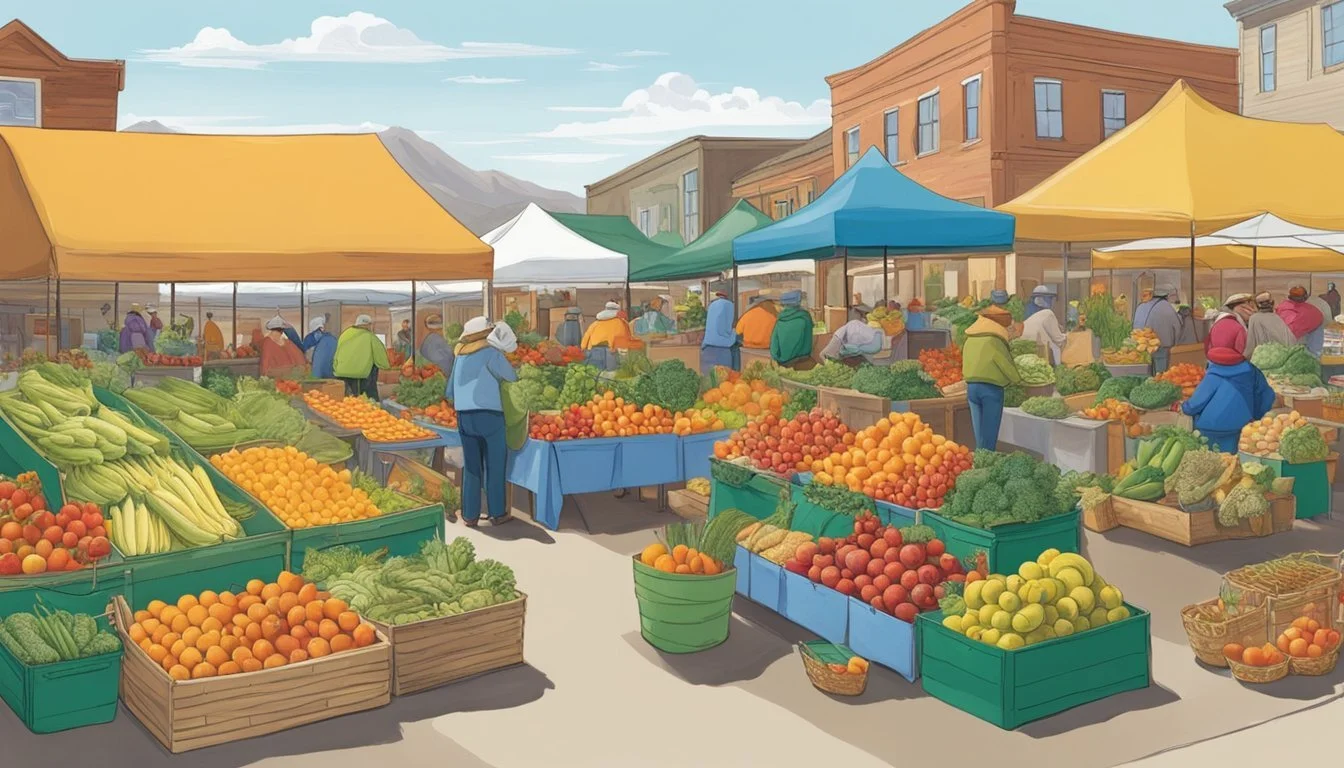Wyoming Seasonal Fruit & Vegetables Guide for February
What's Fresh?
This Article is Part of our Wyoming Seasonal Fruit & Veg Calendar
February in Wyoming presents a unique set of challenges for farmers and gardeners due to its cold climate and short growing season. While the options for local produce this time of year are generally more limited compared to the bountiful summer months, consumers can still find seasonal produce that thrives in cooler conditions. Root vegetables and hearty winter greens are commonly harvested during this period, providing nourishment and fresh options for regional cuisine.
Despite the harsh Wyoming winters, some indoor and hydroponic farms may be able to supply a wider variety of fruits and vegetables. These controlled environments allow for the cultivation of produce that would otherwise not withstand the outdoor February frost. While fresh, locally-grown fruits are scarce this month, preserved or stored fruits from the previous year's harvest, such as apples, can still be enjoyed.
Consumers looking for seasonal produce in Wyoming during February should focus on storage crops and indoor-grown vegetables, such as carrots, potatoes, onions, and some leafy greens, which can often be found at local markets or through community-supported agriculture (CSA) programs. Eating seasonally during the winter months requires adaptability and often reliance on preserved goods, but it supports local agriculture and provides a taste of Wyoming's seasonal offerings.
Understanding Seasonality
As the calendar turns to February in Wyoming, the understanding of seasonality becomes essential in determining what produce is both available and at its peak freshness.
The Role of Season in Produce Availability
The concept of seasonality is critical when discussing the availability of fruits and vegetables. Different crops thrive in different seasonal conditions, and in Wyoming, this cycle dictates not only what is available at any given time but also the quality and flavor of the produce. Winter is a time when the selection of local produce is less varied, yet some hardy vegetables still manage to grow. The produce that is in season during winter months is typically those that can withstand the colder temperatures.
Winter’s Impact on Crop Growth
Winter in Wyoming presents a challenging environment for crop growth, significantly affecting the types of produce that are available. Colder soils and the risk of frost can limit the growth of many plants, making winter-hardy crops more prominent during this season. The produce that does thrive, including certain root vegetables and leafy greens, does so because these plants can survive or even require the cold to reach their peak flavor and texture.
Fruits of February in Wyoming
In the brisk climate of Wyoming, February's fruit selection is predominantly citrus, offering a fresh, vibrant burst of flavor during the colder months.
Citrus Fruits as Winter Staples
Wyoming's February fruit landscape is spearheaded by citrus fruits, which maintain their status as winter staples. Among them, grapefruits and lemons are commonly available, known for their tangy and zesty qualities. These citrus fruits not only provide essential Vitamin C but also bring a lively taste to the winter palette.
Grapefruits: They are at their juiciest, and you can find them in varieties ranging from ruby red to white.
Lemons: In-season and perfect for culinary uses, from baking to adding a fresh twist to beverages.
Other Seasonal Fruits Available
While citrus takes center stage, other fruits still make a welcome appearance in the seasonal produce of February.
Blood Oranges: With their distinctive crimson flesh, blood oranges offer a sweet and slightly tart flavor and are excellent for fresh eating and in salads.
Apples: Late storage varieties of apples remain crisp and are suitable for both eating fresh and cooking.
Fruits such as kiwi, with its tropical taste and rich nutrients, and pomegranates, which are nearing the end of their season, provide additional variety to the range of seasonal produce. These fruits, in all their diversity, contribute to a healthy and flavorful diet during the chill of Wyoming's February.
Wyoming's February Vegetables
In Wyoming's cool February climate, gardeners and consumers can find a bounty of cold-hardy vegetables that thrive despite the chill. These vegetables are not only resilient but packed with nutrients, making them ideal for winter consumption.
Cruciferous Varieties and Leafy Greens
Cruciferous vegetables such as cabbage, kale, cauliflower (how long does cauliflower last?), and broccoli are robust throughout the winter months. They are well-suited for the colder temperatures in Wyoming and can be utilized in a variety of dishes from stews to salads. In particular, Brussels sprouts (how long do brussels sprouts last?) and kale stand out for their ability to withstand frost, which can sometimes enhance their flavors.
Cabbage: Rich in vitamins and versatile for side dishes or fermented as sauerkraut (how long does sauerkraut last?).
Kale: A nutrient-dense green perfect for salads, chips, or a cooked side dish.
Cauliflower: Ideal for roasting or as a low-carb substitute in many recipes.
Brussels sprouts: Great for roasting or adding to hearty winter dishes.
These vegetables are not only nourishing but also add a fresh, green element to meals during the sparse winter months.
Root Vegetables During the Cold Months
Root vegetables are particularly abundant in February, offering robust flavors and textures perfect for grounding winter meals. Gardeners tend to harvest these vegetables, or purchase them from local markets, where they are often stored effectively for winter use.
Carrots and beets: Eaten raw, roasted, or boiled, providing a sweet, earthy component to dishes.
Potatoes: A staple root vegetable that is versatile for a myriad of culinary uses.
Parsnips, turnips, and leeks: Offer distinctive flavors to soups, roasts, and purees.
Garlic: Used to enhance flavor profiles in virtually any savory dish.
These root vegetables provide essential nutrients and contribute heartiness to meals, especially important during the cold season. Their storage capability also makes them a practical choice in Wyoming's winter diet.
Preparing Seasonal Produce
In the heart of winter, Wyoming’s seasonal produce offers a unique palette for nourishing and warming dishes. One can transform these ingredients into delightful meals through various cooking techniques and fresh preparations.
Cooking Techniques for Warming Meals
Cooking with seasonal produce in February centers around comfort foods that warm the body and elevate the spirit. Root vegetables like sweet potatoes (What wine goes well with sweet potatoes?) become a kitchen staple, finding their way into an assortment of recipes. They can be mashed for a creamy side dish or roasted to bring out their inherent sweetness. Soups and stews are essential winter dishes, with the addition of fiber-rich ingredients such as sweet potatoes and leafy greens enhancing their nutritional value.
Soups: Aromatic additions like ginger heighten the flavor profile.
Roasted Vegetables: Roasted broccoli, seasoned with balsamic, serves as a satisfying side.
Moreover, one shouldn't overlook the heartiness of a sauté. Sautéed leafy greens can accompany any main dish as a healthy and flavorful option.
Fresh Preparations for Winter Produce
Even in the colder months, fresh preparations have their place on the Wyoming table. Salads composed of hearty winter greens work beautifully with a bright, homemade dressing. Winter citrus fruits can elevate the simplest of salads with a punch of flavor and a boost of vitamin C.
Salads: Pair leafy greens with segments of oranges or grapefruits for a refreshing touch.
Slaws: Incorporate shredded sweet potatoes for a twist on the traditional slaw.
For those craving something sweet, winter produce in Wyoming inspires a variety of desserts. Citrus fruits become the star of desserts such as tarts and citrus-infused cakes, offering a zesty counterpoint to the richness of winter fare.
Desserts: Blood oranges can offer a stunning visual and taste to winter desserts.
From savory stews to crisp slaws and zesty desserts, Wyoming's February offerings can be transformed through thoughtful preparation into dishes that satisfy both the desire for warmth and the need for fresh, vibrant flavors.
Enhancing Health with Seasonal Foods
In Wyoming's colder months, selecting in-season produce can play a crucial role in maintaining one's health. These foods offer robust vitamins and nutrients which are vital for bolstering the immune system and preserving overall well-being.
Nutritional Benefits of Eating In Season
Fruits and vegetables harvested during their appropriate seasons tend to possess a higher nutritional value. For instance, winter squash, including pumpkins, are not only flavorful but also rich in vitamins, such as vitamin A, which is essential for healthy eyes and skin. Furthermore, in-season produce often contains more antioxidants, such as vitamin C and beta-carotene, which can help reduce inflammation and guard against various diseases.
One can look for the following seasonal items in February in Wyoming to maximize these benefits:
Pumpkin: Offers a wealth of vitamins including vitamins A, C, and E, and is rich in minerals like potassium.
Cauliflower: Known for its versatility in recipes, cauliflower is high in fiber and provides vitamin C, which supports the immune system.
Boosting the Immune System with Fresh Produce
Consuming fresh, seasonal produce is one way to naturally strengthen the immune system. Fresh fruits and vegetables are often more flavorful and nutrient-dense, providing the body with the necessary components to ward off infections. In February, dietary fiber from vegetables such as cauliflower aids digestion and enhances gut health, which is directly linked to immune function.
Vitamin C: Present in high levels in many fruits like grapes, which are a sweet addition to any meal or snack.
Vitamin K: Found abundantly in greens, contributes to maintaining bone health and proper blood clotting.
By focusing on these seasonal foods, one can support their health and strengthen their immune response during winters in Wyoming.
Local Food Scene in Wyoming
Wyoming's local food scene thrives with its unique offerings derived from both farming communities and state-supported initiatives. Emphasizing local production and seasonal availability, it provides residents and visitors with a taste of the state's agricultural capabilities.
Farmers' Markets and Community Supported Agriculture
Wyoming plays host to a multitude of farmers' markets across the state, offering fresh, locally-sourced produce, meats, and handcrafted goods. These markets serve as a hub for community engagement and allow consumers to directly support local farmers and artisans. Community Supported Agriculture (CSA) programs are also a significant part of the food scene, where community members purchase a share from local farms and, in return, receive seasonal produce and other farm products.
Notable Wyoming Farmers' Markets:
Cheyenne Farmers Market
Laramie Farmers Market
Jackson Hole Farmers Market
CSA Programs Highlights:
VeggieBox: Offers a variety of local and regionally grown vegetables and fruits.
Farmers provide weekly or bi-weekly shares of their harvest, often including unique varieties tailored to Wyoming's climate.
State Grants and Agricultural Programs
The Wyoming Department of Agriculture supports local farmers and the food scene through various grant programs and agricultural initiatives. These grants are instrumental in bolstering the state’s agricultural infrastructure, allowing farmers to scale their operations, improve sustainability, and enhance distribution channels to reach a broader market.
Key State Initiatives:
Specialty Crop Grant Program: Supports the growth of unique crops in Wyoming’s diverse terrain.
Wyoming's Food Freedom Act: Encourages local entrepreneurship by reducing regulatory barriers for small-scale producers.
The cohesive efforts of local producers and state programs ensure the availability of fresh, seasonal foods, fostering a resilient and diverse Wyoming food scene.
Concluding Thoughts
Wyoming's February harvest offers an array of produce that can enhance one's diet and well-being during this winter month. Seasonal vegetables, such as collard greens (how long do collard greens last?), contain valuable nutrients like vitamin K and fiber. Wyomingites can capitalize on these in-season offerings for both their health benefits and the enhanced flavors that come with peak maturity.
Utilizing local produce in recipes during this time not only supports sustainability but also ensures that meals are infused with the freshest ingredients. Home cooks in Wyoming can create flavorful dishes based on what's readily available. For example, incorporating hardy vegetables into soups and stews can make for hearty winter meals that are both nutritious and comforting.
When buying February produce, consumers also contribute to the local economy. By prioritizing seasonal produce, shoppers support Wyoming farmers and the agricultural sector, which is crucial for the state's economy.
Below is a list of February's in-season produce in Wyoming:
Vegetables:
Collard Greens
Root vegetables like beets and carrots
Fruits:
Citrus fruits including mandarins
During this month, these selections are at their peak, promising the best in flavor, texture, and nutritional content. Wyoming residents are encouraged to explore these seasonal offerings, experiment with new recipes, and enjoy the wholesome benefits that come with eating produce that is harvested at its best.









